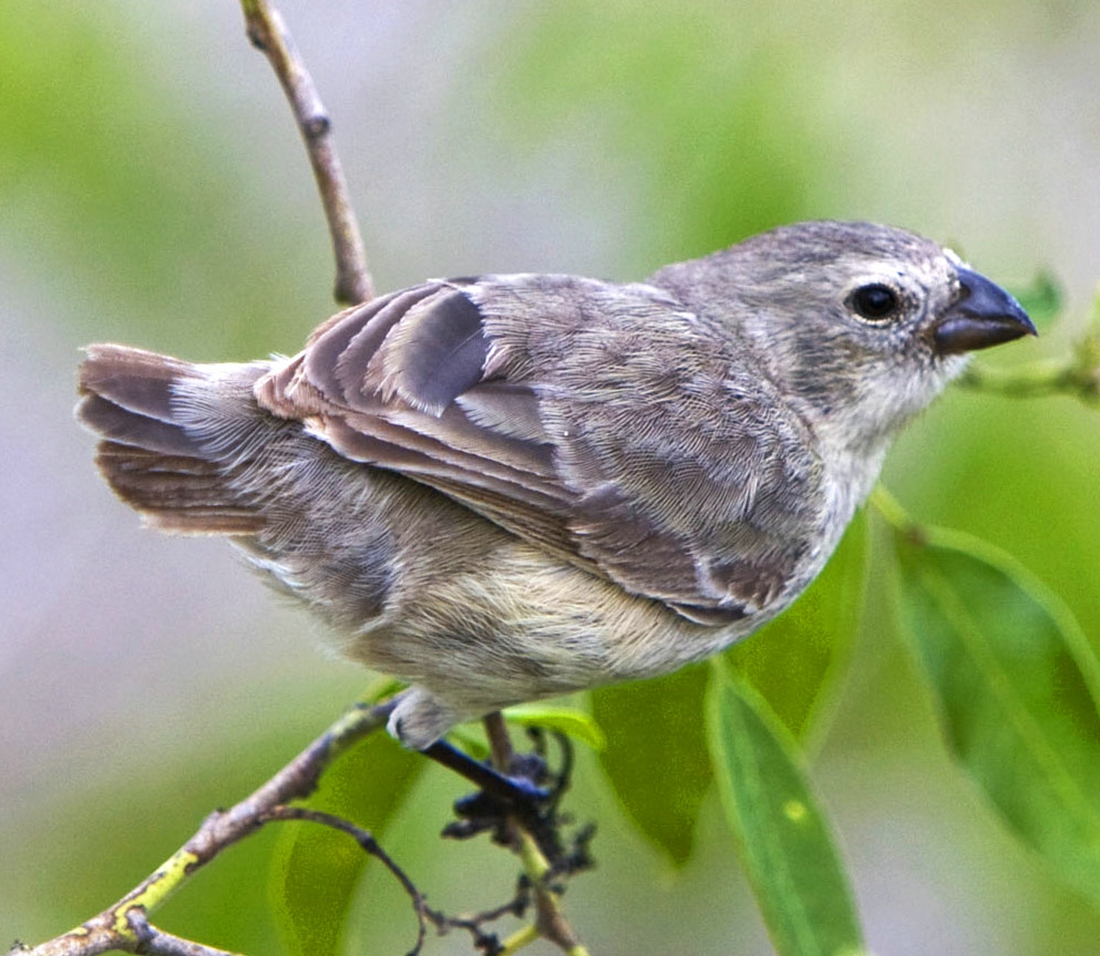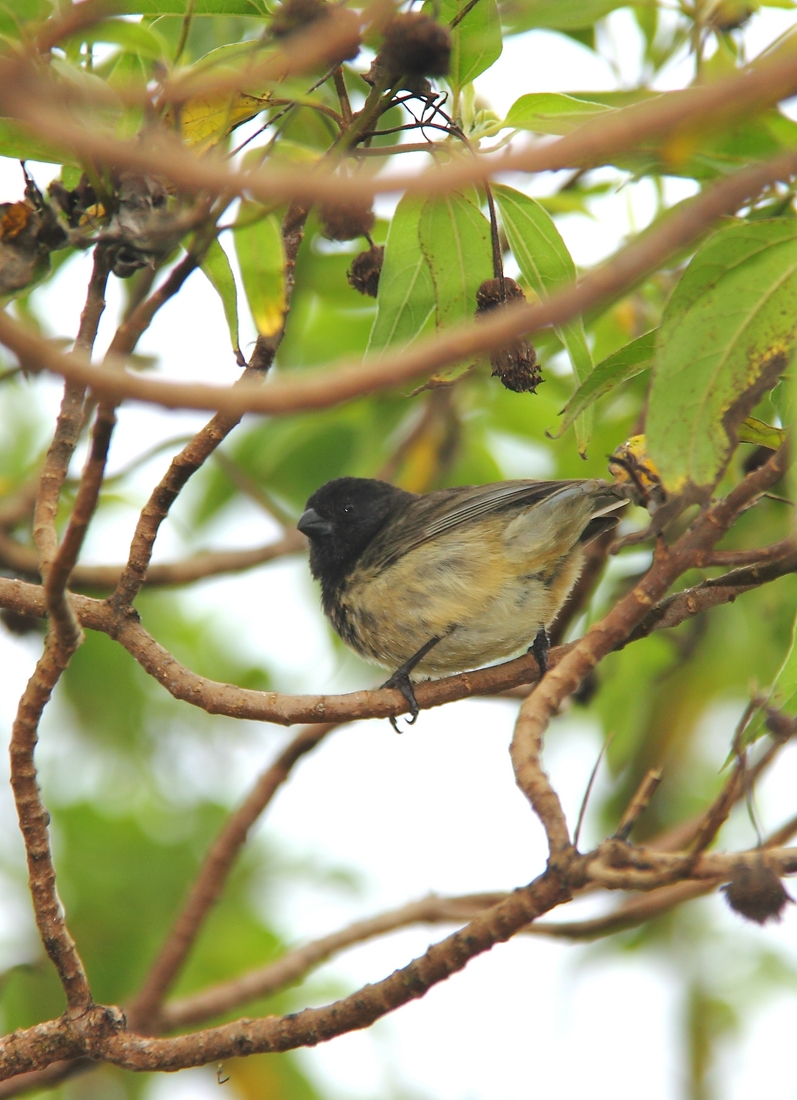Galapagos Species Database
The Galapagos Species Database shares the information about the species from our Natural History Collections.
Camarhynchus pauper
Pinzón de Árbol Mediano, Pinzón arboreo mediano, Medium Tree Finch




Threats Threats are similar to all other finches, particularly very low nesting success due to the introduced parasitic fly Philornis downsi: the flies lay the eggs in the nest and larvae suck the blood of the nestlings, causing anaemia, lesions and consequently nestling mortality. There is predation by the introduced black rat. The impact of diseases is unknown.
Domain
Eukaryota
Kingdom
Animalia
Phylum
Chordata
Class
Aves
Order
Passeriformes
Family
Thraupidae
Genus
Camarhynchus
Species
pauper
Taxon category: Accepted
Taxon origin: Endemic
Reproduction mode: Exclusively sexual
Reproductive biology: Males display in front of a dome shape nest high up in the canopy. Once chosen, the pair either use this nest or build a new one. Only females incubate (two to three eggs), both feed the chicks. Fledglings stay for up to 6 weeks with a parent, either with the male while the female starts a new clutch, or, one with the female and the other with the male.
- Wiedenfeld, D.A. (2006) Aves, the Galapagos Islands, Ecuador. Check List 2006 2(2): 1-27.
- Jiménez-Uzcátegui, G. Milstead, B., Márquez, C., Zabala, J., Buitrón, P., Llerena, A., et al. (2007) Galapagos vertebrates: endangered status and conservation actions. Galapagos Report 2006–2007. Charles Darwin Foundation, Puerto Ayora, p. 104–110.
- Granizo, T. Pacheco, C., Rivadeneira, M. B., Guerrero M. & Suárez, L. (eds.) (2002) Libro Rojo de las Aves del Ecuador. SIMBIOE/Conservation International/EcoCiencia/Ministerio del Ambiente/IUCN. Serie Libros Rojos del Ecuador, tomo 2. Quito, Ecuador.
- Harris, M.P. (1973) The Galápagos avifauna. Condor 75(3): 265-278.
- Swarth, H.S. (1931) The Avifauna of the Galapagos Islands. Occ. Pap. Calif. Acad. Sci. 18: 1-299.
- Kleindorfer, S. Dudaniec, R.Y. (2006) Increasing prevalence of avian poxvirus in Darwin’s finches and its effect on male pairing success. Journal of Avian Biology 37: 69-76.
- Wiedenfeld, D.A. Jiménez-Uzcátegui, G. (2008) Critical problems for bird conservation in the Galapagos Island. Cotinga 29: 22-27.
- Bisconti, M. Landini, W., Bianucci, G., Cantalamessa, G., Carnevale, G. Ragaini, L. & Valleri, G. (2001) Biogeographic relationships of the Galapagos terrestrial biota: parsimony analyses of endemicity based on reptiles, land birds and Scalesia land plants. J. Biogeogr. 28: 495-510.
- Christensen, R. Kleindorfer, S. (2009) Jack-of-all-trades or master of one? Variation in foraging specialisation across years in Darwin’s Tree Finches (Camarhynchus spp.). Journal of Ornithology 150:383-391.
- Kleindorfer, S. O’Connor, J., Dudaniec, R., Myers, S., Robertson, J. & Sulloway, F. (2014) Species collapse via hybridization in Darwin’s Tree Finches. The American Naturalist 183: 325-341
- Farrington, H. Lawson, L., Clark, C. & Petren, K. (2014) The evolutionary history of Darwin's finches: speciation, gene flow, and introgression in a fragmented landscape. Evolution doi 10.1111/evo.12484.
- IUCN (2015) The IUCN Red List of Threatened Species. Version 2015-4. <www.iucnredlist.org>. Downloaded on 20 November 2015.
- Lamichhaney, S. Berglund, J., Sällman Almén, M., Maqbool, K., Grabherr, M., Martinez-Barrio, A., Promerova, M., Rubin, C.J., Wang, C., Zamani, N., Grant, B.R., Grant, P.R., Webster, M.T., Andersson, L. (2015) Evolution of Darwin’s finches and their beaks revealed by genome sequencing Nature 518: 371-386. doi:10.1038/nature14181
- Remsen, J.V. Areta, J.I.Jr., Cadena, C.D., Claramunt, S., Jaramillo, A., Pacheco, J.F., Pérez-Emán, J., Robbins, M.B., Stiles, F.G., Stotz, D.F., Zimmer, K. J. (2016) A Classification of the Bird Species of South America. South American Classification Committee. American Ornithologists' Union http://www.museum.lsu.edu/~Remsen/SACCBaseline.htm
- IUCN (2017) The IUCN Red List of Threatened Species Version 2016-3. <www.iucnredlist.org>. Downloaded on 03 February 2017.
- Freile, J.F. Santander, T., Jiménez-Uzcátegui, G., Carrasco, L., Cisneros-Heredia, D., Guevara, E., Sánchez-Nivicela, M., Tinoco, B. (2019) Lista Roja de las aves del Ecuador Quito, Ecuador. 97 pp.


